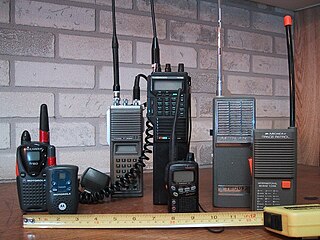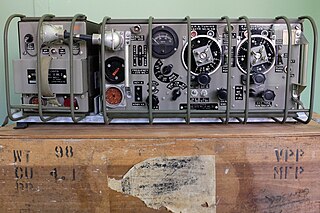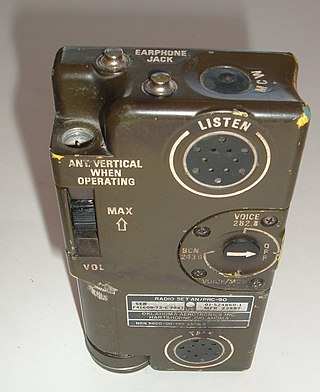

The Paraset was a small, low-power, thermionic valve, CW-only radio transmitter-receiver supplied to the resistance groups in France, Belgium and the Netherlands during World War II.


The Paraset was a small, low-power, thermionic valve, CW-only radio transmitter-receiver supplied to the resistance groups in France, Belgium and the Netherlands during World War II.
The Paraset was one of the first successful miniaturized radio sets for Britain's Special Operations Executive which conducted espionage and other activities behind German lines during World War II.
The set, known as the Whaddon Mark VII, was used for clandestine radio communication primarily in Norway and Europe, developed at the Royal Signals Special Communications Unit workshops at Little Horwood and the workshops of Whaddon Hall, Buckinghamshire in the early stages of World War II. The equipment is known as the "Paraset" because it was dropped by parachute for field agents. [1] [2] [3]
A number of amateur radio operators build and operate replicas of the Paraset. [4]

Shortwave radio is radio transmission using radio frequencies in the shortwave bands (SW). There is no official definition of the band range, but it always includes all of the high frequency band (HF), which extends from 3 to 30 MHz ; above the medium frequency band (MF), to the bottom of the VHF band.

Software-defined radio (SDR) is a radio communication system where components that conventionally have been implemented in analog hardware are instead implemented by means of software on a computer or embedded system. While the concept of SDR is not new, the rapidly evolving capabilities of digital electronics render practical many processes which were once only theoretically possible.

A walkie-talkie, more formally known as a handheld transceiver, HT, or handheld radio, is a hand-held, portable, two-way radio transceiver. Its development during the Second World War has been variously credited to Donald Hings, radio engineer Alfred J. Gross, Henryk Magnuski and engineering teams at Motorola. First used for infantry, similar designs were created for field artillery and tank units, and after the war, walkie-talkies spread to public safety and eventually commercial and jobsite work.

Rockwell Collins, Inc. was a multinational corporation headquartered in Cedar Rapids, Iowa, providing avionics and information technology systems and services to government agencies and aircraft manufacturers. It was formed when the Collins Radio Company, facing financial difficulties, was purchased by Rockwell International in 1973. In 2001, the avionics division of Rockwell International was spun off to form the current Rockwell Collins, Inc., retaining its name.
The R. L. Drake Company is a manufacturer of electronic communications equipment located in Springboro, Ohio. It is also known for its line of equipment for amateur radio and shortwave listening, built in the 1950s through the 1980s. The company operates as a separate entity owned by Blonder Tongue Laboratories, Inc.

An amateur radio repeater is an electronic device that receives a weak or low-level amateur radio signal and retransmits it at a higher level or higher power, so that the signal can cover longer distances without degradation. Many repeaters are located on hilltops or on tall buildings as the higher location increases their coverage area, sometimes referred to as the radio horizon, or "footprint". Amateur radio repeaters are similar in concept to those used by public safety entities, businesses, government, military, and more. Amateur radio repeaters may even use commercially packaged repeater systems that have been adjusted to operate within amateur radio frequency bands, but more often amateur repeaters are assembled from receivers, transmitters, controllers, power supplies, antennas, and other components, from various sources.

Yaesu FT-101 is a model line of modular amateur radio transceivers, built by the Yaesu Corporation in Japan during the 1970s and 1980s. FT-101 is a set that combines a solid state transmitter, receiver and a tube final amplifier. Its solid state features offer high-performance, low-current characteristics and its tube amplifier provides an almost mismatch-resistant transmitter and tuner stage. FT-101s were made with plug-in circuit boards that could be sent to the dealer or factory for replacement or repair. Until then, modular design was unprecedented in the amateur community. This also explains the fact why so many FT-101s are still in use today. The rig was sold worldwide as Yaesu FT-101 and in Europe as Yaesu FT-101 and as Sommerkamp FT-277. Because of its reliability it earned its nickname "the workhorse".

Vintage amateur radio is a subset of amateur radio hobby where enthusiasts collect, restore, preserve, build, and operate amateur radio equipment from bygone years, such as those using vacuum tube technology. Popular modes of operation include speaking over amplitude modulation (AM), and communicating using Morse code through continuous wave (CW) radiotelegraphy. Some enthusiasts have interest in owning, restoring and operating vintage military and commercial radio equipment such as those from 1940s to 1960s. Some undertake to construct their own gear, known in ham slang as homebrewing, using vintage parts and designs. A number of amateur radio clubs and organizations sponsor contests, events, and swap meets that cater to this specialized aspect of the hobby.

The AN/ART-13 was a radio transmitter manufactured by Collins Radio that found widespread use during and after World War II in military aircraft.
Swan Electronics was a manufacturer of amateur radio gear located in Oceanside, California, United States.

Radio is the technology of communicating using radio waves. Radio waves are electromagnetic waves of frequency between 3 hertz (Hz) and 300 gigahertz (GHz). They are generated by an electronic device called a transmitter connected to an antenna which radiates oscillating electrical energy, often characterized as a wave. They can be received by other antennas connected to a radio receiver; this is the fundamental principle of radio communication. In addition to communication, radio is used for radar, radio navigation, remote control, remote sensing, and other applications.

The Wireless Set No. 19 was a Second World War mobile radio transceiver designed for use by armoured troops of the British Army. First introduced in 1940, the No. 19 began to replace the pre-war Wireless Set No. 11. Two modified versions were introduced, Mk. II in 1941 and Mk. III in 1942. An improved version from Canada was introduced in 1942 for use primarily with other forces. In British service, the No. 19 was replaced in the post-war era by the Larkspur radio system. Canadian-built No. 19s saw continued service for many years with a variety of users.

The SCR-536 was a hand-held radio transceiver used by the US Army Signal Corps in World War II. It is popularly referred to as a walkie talkie, although it was originally designated a "handie talkie".

Survival radios are carried by pilots and search and rescue teams to facilitate rescue in an emergency. They are generally designed to transmit on international distress frequencies. Maritime systems have been standardized under the Global Maritime Distress Safety System. Civil and military organisation's utilized different frequencies to communicate and no infringement on either sector would take place. For emergencies involving civilian aircraft, the radio frequency used is VHF 121.5 MHz and for military aircraft incidents, the frequency used is UHF 243 MHz.

The SCR-300, designated AN/VRC-3 under the Joint Electronics Type Designation System, was a portable radio transceiver used by US Signal Corps in World War II. This backpack-mounted unit was the first radio to be nicknamed a "walkie talkie".
The Yaesu VX series is a line of two sequences of compact amateur radio handheld transceivers produced by Yaesu. There is a line of ultra-compact lower-power dual-band transceivers that started with the VX-1R and was later updated with the VX-2R and VX-3R. There is also a line of 5 W tri-band transceivers that started with the VX-5R and was later updated with the VX-6R, VX-7R and VX-8R.

The Wireless Set No. 62 was a British Army HF band radio transceiver. Introduced by Pye during the later part of World War II as a light-weight and waterproof replacement for the Wireless Set No. 22. Although intended as an interim design, it remained in production until 1966.
{{cite web}}: CS1 maint: numeric names: authors list (link)